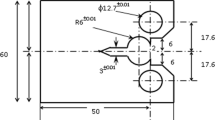Abstract
Fracture-toughness properties should be measured in the laboratory at loading rates and temperatures similar to those expected in the application of interest. This is not usually the case because of the experimental difficulties involved. This report describes a method being used to obtainJ Ic, J-R curves, andJ at cleavage for three-point-bend tests conducted at drop tower rates through the ductile to brittle transition regime of the ferritic A106 steel being tested. The major conclusion is that these tests can now be accomplished, though a high degree of expertise and considerable practical experience is necessary to obtain good test results. The steel tested here is quite rate dependent as shown both by tensile tests and fracture-toughness tests. A load elevation of 30 to 50 percent results in the drop tower 100 in./s (2.5 m/s) tests on this material in comparison with static tests when both tests are conducted on the ductile upper shelf. Nonetheless, for this materialJ Ic andJ-R curves are not elevated by the loading rate. Looking at the elastic and plastic components ofJ one sees that theJ EL increases with increased loading rate but also thatJ PL decreases with loading rate. It is also demonstrated that for the high rate tests more crack extension is present at a given bend angle for the rapid tests than with the static tests.
Similar content being viewed by others
References
Hasson, D.F. andJoyce, J.A., “The Effect of a Higher Loading Rate on the J Ic Fracture Toughness Transition Temperature of HY Steels,”J. Eng. Mat. and Tech., ASME,103,133–141 (1981).
Joyce, J.A., Ernst, H. and Paris, P.C., “Direct Evaluation of J Resistance Curves from Load Displacement Records,” Fracture Mechanics: Twelfth Conference, ASTM STP 700, Amer. Soc. for Test. and Mat., 222–236 (1980).
Joyce, J.A., “Static and Dynamic J-R Curve Testing of A533B Steel using the Key Curve Analysis Technique,” Fracture Mechanics: Fourteenth Symposium, Vol. I: Theory and Analysis, ASTM STP 791, Amer. Soc. for Test. and Mat., 543–560 (1983).
Joyce, J.A. and Czyryca, E.J., “Dynamic J I-R Curve Testing of HY-130 Steel,” David W. Taylor Naval Ship Res. and Dev. Center, Rep. DTNSRDC/SME-81/57, Annapolis, MD (Oct. 1981).
Joyce, J.A. and Hackett, E.M., “Dynamic J-R Curve Testing of a High Strength Steel Using the Key Curve and Multispecimen Technique,” Fracture Mechanics: Seventeenth Volume, ASTM STP 905, Amer. Soc. for Test. and Mat., 741–774 (1986).
Joyce, J.A. and Hackett, E.M., “An Advanced Procedure for J-R Curve Testing in the Drop Tower,” presented at the 3rd Int. Conf. on Non-linear Fracture Mechanics, ASTM, (Oct. 1986).
Nakamura, T., Shih, C.F. and Freund, L.B., “Three Dimensional Simulation of a Dynamically Loaded Three-Point-Bend Ductile Fracture Specimen,” presented at the 3rd Int. Conf. on Nonlinear Fracture Mechanics, ASTM (Oct. 1986).
Hackett, E.M., Joyce, J.A. and Shih, C.F., “Measurement of Dynamic Fracture Toughness of Ductile Materials,” presented at the 3rd Int. Conf. on Nonlinear Fracture Mechanics (Oct. 1986).
Ernst, H.A., Paris, P.C., Rossow, M. and Hutchinson, J.W., Fracture Mechanics, ASTM STP 677, Amer. Soc. for Test. and Mat., 581–599 (1979).
Mecklenberg, M.F., Joyce, J.A. and Albrecht, Pedro, “Separation of Energies in Elastic-Plastic Fracture,” presented at the 3rd Int. Conf. on Non-linear Fracture Mechanics, ASTM (Oct. 1986).
Author information
Authors and Affiliations
Rights and permissions
About this article
Cite this article
Joyce, J.A., Hackett, E.M. Transition range drop tower J-R curve testing of A106 steel. Experimental Mechanics 29, 274–278 (1989). https://doi.org/10.1007/BF02321407
Received:
Revised:
Issue Date:
DOI: https://doi.org/10.1007/BF02321407



